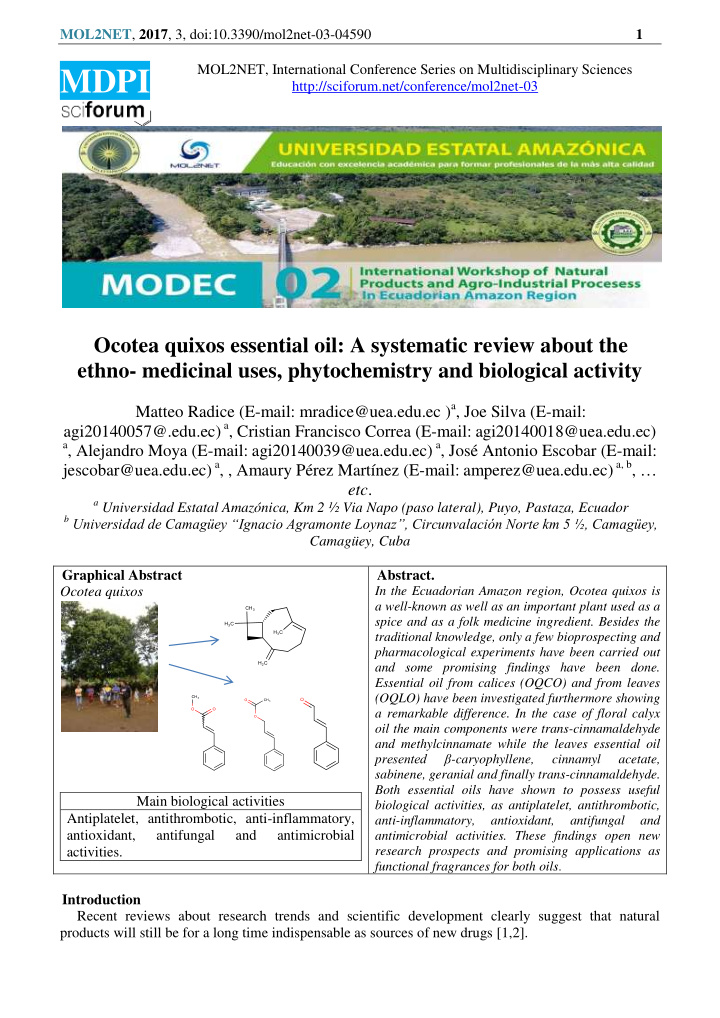



MOL2NET , 2017 , 3, doi:10.3390/mol2net-03-04590 1 MOL2NET, International Conference Series on Multidisciplinary Sciences MDPI http://sciforum.net/conference/mol2net-03 Ocotea quixos essential oil: A systematic review about the ethno- medicinal uses, phytochemistry and biological activity Matteo Radice (E-mail: mradice@uea.edu.ec ) a , Joe Silva (E-mail: agi20140057@.edu.ec) a , Cristian Francisco Correa (E-mail: agi20140018@uea.edu.ec) a , Alejandro Moya (E-mail: agi20140039@uea.edu.ec) a , José Antonio Escobar (E-mail: jescobar@uea.edu.ec) a , , Amaury Pérez Martínez (E-mail: amperez@uea.edu.ec) a, b , … etc . a Universidad Estatal Amazónica, Km 2 ½ Via Napo (paso lateral), Puyo, Pastaza, Ecuador b Universidad de Camagüey “Ignacio Agramonte Loynaz”, Circunvalación Norte km 5 ½, Camagüey, Camagüey, Cuba Graphical Abstract Abstract. Ocotea quixos In the Ecuadorian Amazon region, Ocotea quixos is a well-known as well as an important plant used as a spice and as a folk medicine ingredient. Besides the traditional knowledge, only a few bioprospecting and pharmacological experiments have been carried out and some promising findings have been done. Essential oil from calices (OQCO) and from leaves (OQLO) have been investigated furthermore showing a remarkable difference. In the case of floral calyx oil the main components were trans-cinnamaldehyde and methylcinnamate while the leaves essential oil pr esented β -caryophyllene, cinnamyl acetate, sabinene, geranial and finally trans-cinnamaldehyde. Both essential oils have shown to possess useful Main biological activities biological activities, as antiplatelet, antithrombotic, Antiplatelet, antithrombotic, anti-inflammatory, anti-inflammatory, antioxidant, antifungal and antioxidant, antifungal and antimicrobial antimicrobial activities. These findings open new activities. research prospects and promising applications as functional fragrances for both oils . Introduction Recent reviews about research trends and scientific development clearly suggest that natural products will still be for a long time indispensable as sources of new drugs [1,2].
MOL2NET , 2017 , 3, doi:10.3390/mol2net-03-04590 2 In the context of the novel therapeutic strategies and bio prospecting, the Amazonian region has to be considered an essential source of natural molecules, traditional medicine and ancestral knowledge. Tropical belt includes 17 "Mega diverse Countries" [3,4] and Ecuador is part of this important guild and has a notable ranking for its high biological diversity. As reported by Sierra et al ., (2002) and Lessmann et al , (2014), considering the relationship between land area and number of species Ecuador seems to be the most biodiverse country on the planet [5,6]. In the American continent, the mega- diverse countries are Ecuador, Brazil, Colombia, Peru, Venezuela, Mexico and the United States. Other relevant countries for biodiversity in the world are Australia, New Guinea, Madagascar, Democratic Republic of Congo, South Africa, Indonesia, India, Philippines, Malaysia and China. Ecuador is the smallest country in territorial area among the mega-diverse countries, Thus, could be considered one of the richest areas for biodiversity [7]. Considering the above-mentioned biodiversity, Ecuador can provide a large number of bioactive molecules and essential oils that have been increasingly studied in order to understand their applications. Recent findings have allowed demonstrating different uses as a food preservative, for cosmetic formulation and for pharmaceutical preparations [2,8-13]. In the last decade Ocotea quixos essential oils have been studied in order to update the knowledge about this plant. For several years, Ocotea quixos was considered native to Ecuador and endemic of the local rainforest, nevertheless, deepened studies described the presence of this species also in Peru and Colombia, therefore in any case Ocotea quixos represents an emblematic tree of the Ecuadorian Amazonian Region [14,15]. Even if the findings about O. quixos are few, the promising data regarding the recent in vitro and in vivo studies and the aromatic properties mentioned since the Inca’s age [16] encourage new researches on this species. Hence, the aim of this review paper was to collect an up to date and exhaustive critical study about Ocotea quixos essential oil scientific literature, covering its traditional ethno-medicinal uses, phytochemistry and biological activities. Materials and Methods The present systematic review was achieved adopting the following electronic databases: Scifinder, Pubmed, ISI-Web of Science, Google Scholar, Scielo and Scopus. Data was independently extracted from six reviewers and the final papers selections were completed avoiding duplication of data. The following keywords were selected: Ocotea quixos , ishpingo, ishpink, canela amazónica. Figure 1. Selection strategy for eligible articles All key words were searched individually and in combination. The reviewers selected articles in English and Spanish language, finally data from patents, symposiums and congress abstracts was excluded. The oldest selected articles is dated 1981 and some key papers for the first three chapters were also considered. As described in Fig. 1, the above-mentioned criteria allowed selecting 38 eligible articles. The second step allowed eliminating duplicated papers, resulting in 25 articles. Finally, two papers, which did not satisfy the selection methodology, were rejected because of the lack of clarity in their procedures. Results and Discussion 2.1 Botanical description, historical information and folk medicine. Ocotea quixos (Lam.) Kosterm. ( Lauraceae ) belongs to the Lauraceae family. The Ocotea genus incorporates about 350 tropical and subtropical trees and shrubs characterized for the presence of
Recommend
More recommend